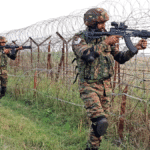Tension in Syria: Rebels cannons reached the capital Damascus; President Assad fled the country

The situation in Syria has become very tense. Their army is weakening, and the fighters are capturing cities one after the other. Now, they have captured the major city of Homs and have moved towards the capital, Damascus. It is said that the rebel army has also captured Damascus. Rebel commanders have reached the capital with their cannons and equipment. Local citizens have claimed a fierce battle is going on for capture at many places. Gun firing is taking place in many places.
A news agency has claimed that Syrian President Bashar al-Assad has left for some unknown place in a special plane from the country. Meanwhile, there is an atmosphere of panic and mess at Damascus International Airport. Fearing the loss of power of President Bashar al-Assad, his supporters are struggling to flee from the country.
After capturing Hama, Aleppo, and Daraa, Homs is the fourth major city that has been captured by the rebels. Some videos that have emerged on social media tell the story of the capture of the city. A video has also emerged in which sounds of gunfire can be heard between Syrian rebels fighting with government forces for control of the major city of Homs and rebel fighters are seen on the streets.
Rebels celebrated by firing bullets
After the army exited from the central city, thousands of Homs citizens came out on the streets and celebrated by shouting slogans: “Assad is gone, Homs is free” and “Long live Syria, down with Bashar al-Assad.” The rebels celebrated by firing bullets in the air, while eager youths ripped off the posters of Syrian President Assad. According to a news agency, when opposition troopers reached the suburbs of Damascus, Bashar Assad, who was the president of the country for 24 years, was not traceable.
The rebels openly fired bullets on the streets of Homs and have so far captured four big cities. The capture of Homs is potentially the biggest disappointment for Assad. Now these rebels are moving towards the Syrian capital, Damascus.
ALSO READ: The president declared martial law in South Korea

The city of Homs, situated between Syria’s coastal provinces Latakia and Tartus, is a crucial city connecting Damascus to the Mediterranean coast, which is now under the control of the rebels. After capturing the city, its connection with the coastal areas of the capital has been cut off where people of Assad’s Alawite community live. There is another interesting thing: Russia operates its major naval base here.
Only three provincial capitals are under the control of the government
Activities of the rebels have increased around the capital Damascus. According to a news agency, after the Syrian army was removed from the southern part of the country, many areas, including provincial capitals, have now come under the control of the rebels. For the first time in the country’s long-running civil war, the government now has control over only three of the 14 provincial capitals, which include Damascus, Latakia, and Tartus.
Shortage of essential goods in the market
Damascus’s citizens have now started stocking essential food items. Thousands of people have gone to the Syrian border with Lebanon in an attempt to leave the country. One resident said that many shops in the capital city have closed, and those that are open have run out of essential items. Some shops are selling goods at very high prices. One individual said, “The situation is very strange. We are not used to this.” People fear that they may face revenge.
Removal of Assad is sure?
Protests took place in several outskirts of Damascus, with protesters removing symbols of Assad’s rule. Several witnesses said some soldiers took off their uniforms and joined the protesters. Rebel forces are now within 30 km of the capital Damascus, further risking the government’s hold on power. Foreign officers speaking on condition of obscurity said Assad’s government could fall within some days. A US official evaluated the time frame as 5-10 days, while another said the president could be overthrown from power within a week.

Summary
Syria is almost free from Assad’s control. The capital Damascus has been grabbed by rebels. The army has surrendered to the rebels. Syrian President Bashar al-Assad has fled the country. The Syrian Army Commander announced the end of the Assad government. Syrian rebels also declared on Sunday that the Syrian president has fled the capital. The rebels have declared Damascus free from Assad’s control. The rebels have taken over almost everything, from the police headquarters to the TV network. Rebels’ artillery and tanks are thundering on the streets of the capital Damascus.








